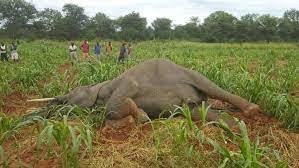
-The Human-Wildlife Conflict Relief Fund will offer some monetary relief to victims of human-wildlife conflict, the cabinet said
John Cassim
HARARE, Zimbabwe – The Zimbabwean government has given the green light for the creation, of a Human-Wildlife Conflict Relief Fund to compensate the victims.
During the post-cabinet media briefing on June 6, an announcement was made, that the Parks and Wildlife Act Amendment Bill has been approved.
The creation of the relief fund was at the center of the Amendment Bill owing to increasing competition for resources by humans and wildlife.
“The Bill will provide for the creation of a Human-Wildlife Conflict Relief Fund, which will offer some monetary relief to victims of human-wildlife conflict,” the Cabinet said.
The approval by the cabinet comes against the backdrop of increased human-wildlife conflicts with 15 deaths and 43 injuries during the first quarter of this year.
The most affected was Mashonaland West province which recorded 19 deaths mostly in Kariba.
This makes Zimbabwean reports the highest in the region with neighbouring Botswana recording the least (57) in the past 10 years, despite having the biggest elephant population of 204 000.
In 2021, 71 deaths and 50 injuries were recorded, compared to 60 deaths and 40 injuries in 2020.
In 2022, 68 people lost their lives to wildlife attacks.
The country recorded 15 deaths and 43 injuries during the first quarter of 2023.
During the same period last year, there were 22 deaths and 18 injuries
Meanwhile, the amendment bill seeks to broaden the scope of the Parks Act by harmonising the Act with all other wildlife legislations.
“The Bill will also provide for the sustainable utilisation, sustainable development, the precautionary principle, community participation, access, and benefit-sharing and to take into cognisance regional and international instruments on wildlife.
The Amendment Bill will repeal the Quelea (Control) Act (Chapter 19:10), and the Trapping of Animals Act (Control) (Chapter 20:21) and align the Act to the Constitution,” Cabinet said.
-Quelea Act
This is an Act, that came about in 1972 and was amended in 1988 aimed at controlling the Quelea birds, their breeding, their survival, and any other incidents around them.
This Act introduced measures against the excessive proliferation of any Quelea in Zimbabwe.
The owner or occupier of any land upon which Queleas are nesting or roosting is required to notify specified local authorities of this fact.
The Act says in Section 3 that the Minister may give orders to occupiers or owners of any land to take such steps or measures to his land as the Minister may consider necessary or desirable for the destruction or con.
Quelea birds are the most numerous bird species in the world, with a peak post-breeding population estimated at 1,8 billion.
The nomadic super-colonies can grow to millions of birds, making Quelea not only the most abundant bird in the world but also the most destructive to cereal grains, especially sorghum and millets as well as wheat, rice, and barley.
FAO has supported SADC countries to beef up response efforts in the urgent ground and aerial spray operations, surveillance, and capacity building including alternative methods for controlling Quelea birds in hardest hit parts of the region.
-Trapping of Animals Act
This is an Act that provides rules relative to the trapping of animals.
The Act consists of 31 sections divided into 7 Parts:
Preliminary (I); Classification of traps (II); Making, possession and use of class I traps prohibited (III); Making, possession and use of class II traps (IV); Making, possession and use of class III traps (V); Restriction of use of class III traps on alienated land (VI); Evidence, prevention and detection of offenses and forfeitures (VII); General (VIII).
Meanwhile, Takudzwa Nzou, a legal officer at Speak Out for Animals said the Bill is an improvement to wildlife law.
“For example, a huge gap in human-wildlife conflict will be addressed. The introduction of the Conflict relief fund will hopefully reduce retaliation killings.
It has been long since the Parks and Wildlife Act has been amended and this will to some extent update the law,” he said.
The bill is reaching its final stages of being enacted into law and what that is left is for the president to sign the Bill and it will repeal the old provisions of the Parks and Wildlife Act.
What is left is for the president to sign the Bill and it will repeal the old provisions of the Parks and Wildlife Act.
